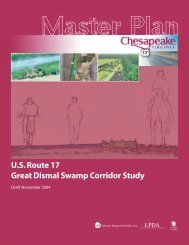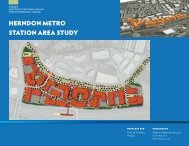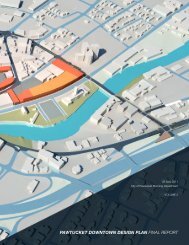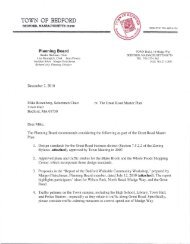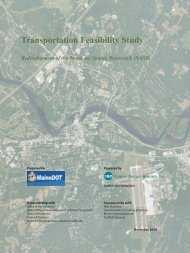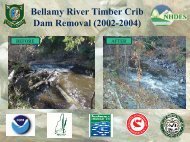New Bedford 2020 - VHB.com
New Bedford 2020 - VHB.com
New Bedford 2020 - VHB.com
- No tags were found...
You also want an ePaper? Increase the reach of your titles
YUMPU automatically turns print PDFs into web optimized ePapers that Google loves.
A City Master Plan <strong>New</strong> <strong>Bedford</strong> <strong>2020</strong>> Under Institutional Uses:• Child care facility in and not in an existing building have the same designations and should be<strong>com</strong>bined.• The designation for hospitals needs to be expanded and updated because today’s society relies on anumber of different healthcare facilities. These uses have different land use impacts and it may not beappropriate for each to have the same designation across the zoning districts. This <strong>com</strong>ment does notinclude smaller medical or dental offices, which are covered in the <strong>com</strong>mercial section of the Table.• Museums and other civic related uses should be added to the Table.> Under Commercial Uses:• Adult and family day care should be moved to institutional uses and <strong>com</strong>bine with large family daycare since the designations for all three are the same.• There is no designation for gas station, which is different from motor vehicle repairs and body repairs.• The City may want to consider separating motel, hotel and inn because the way in which they aredesigned and meant to function are different. Hotels tend to include ancillary services, such asmeeting rooms and restaurants, which increase the level of activity.• Business and professional office or building needs to be reconsidered for a couple of reasons.Conversion of single-family residences to an office is not addressed, yet there are a number of suchstructures that either were converted (presumably they are pre-existing nonconforming uses) and thereare additional opportunities to allow conversion that the City may want to facilitate. It may be anattractive option to provide the option for property owners to convert to an office use, including forhome-based businesses, in or adjacent to the downtown area (this is an option by special permit in theDowntown Business Overlay District). This can attract “low impact” businesses to the downtownarea—ones that would minimize potential impacts to the adjacent neighborhoods.• The way in which retail stores are addressed in the Table should be revisited to include a betterdescription of retail and personal service types of stores. Some typical types of stores are not listed,such as grocery stores and big box retail outlets.• Given the variety of restaurant and bar types, the listing for those uses should be expanded.• Uses that typically have drive-through options should be covered in the use table.• Mixed-use developments should be specifically listed in the Table.• In general, greater specificity is needed in listing uses under this category (industrial as well) in orderto reduce ambiguity.> Under Industrial Uses:• If earth removal, low-level radioactive waste, junkyard, and tire recycling are prohibited activities, theyshould be removed from the use table and addressed elsewhere in the ordinance (low-level radioactivewaste is addressed in Section 2600).• There are several listings for manufacturing-related uses. They should be reworded to reflect currentterminology and <strong>com</strong>bined or separated as necessary in the Table of Principal Use Regulations.• The list of industrial uses in the table needs to be expanded to include life sciences, biotechnology,medical devices, research and development, incubator space and other similar new uses that may bepart of the broader economic development strategy for the City.• Although there are some use designation differences between the Industrial A, B, and C districts,much of them are the same. The dimensional regulations are the same for all three districts. They tendAppendix B: Zoning DiagnosticB-5




